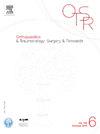Prediction of transfusion risk after total knee arthroplasty: use of a machine learning algorithm
IF 2.3
3区 医学
Q2 ORTHOPEDICS
引用次数: 0
Abstract
Introduction
Total knee arthroplasty (TKA) carries a significant hemorrhagic risk, with a non-negligible rate of postoperative transfusions. The blood-sparing strategy has evolved to reduce blood loss after TKA by identifying the patient's risk factors preoperatively. In practice, a blood count is often performed postoperatively but rarely altering the patient's subsequent management. This study aimed to identify the preoperative variables associated with hemorrhagic risk, enabling the creation of a machine-learning model predictive of transfusion risk after total knee arthroplasty and the need for a complete blood count.
Hypothesis
Based on preoperative data, a powerful machine learning predictive model can be constructed to estimate the risk of transfusion after total knee arthroplasty.
Material and methods
This retrospective single-centre study included 774 total knee arthroplasties (TKA) operated between January 2020 and March 2023. Twenty-five preoperative variables were integrated into the machine learning model and filtered by a recursive feature elimination algorithm. The most predictive variables were selected and used to construct a gradient-boosting machine algorithm to define the overall postoperative transfusion risk model. Two groups were formed of patients transfused and not transfused after TKA. Odds ratios were determined, and the area under the curve evaluated the model's performance.
Results
Of the 774 TKA surgery patients, 100 were transfused postoperatively (12.9%). The machine learning predictive model included five variables: age, body mass index, tranexamic acid administration, preoperative hemoglobin level, and platelet count. The overall performance was good with an area under the curve of 0.97 [95% CI 0.921–1], sensitivity of 94.4% [95% CI 91.2–97.6], and specificity of 85.4% [95% CI 80.6–90.2]. The tool developed to assess the risk of blood transfusion after TKA is available at https://arthrorisk.com.
Conclusion
The risk of postoperative transfusion after total knee arthroplasty can be predicted by a model that identifies patients at low, moderate, or high risk based on five preoperative variables. This machine learning tool is available on a web platform that is accessible to all, easy to use, and has a high prediction performance. The model aims to limit the need for routine check-ups, depending on the risk presented by the patient.
Level of evidence
II; diagnostic study
预测全膝关节置换术后的输血风险:使用机器学习算法。
导言:全膝关节置换术(TKA)有很大的出血风险,术后输血率不容忽视。为了减少 TKA 术后的失血量,我们在术前确定了患者的风险因素,从而制定了节约用血策略。实际上,血细胞计数通常在术后进行,但很少会改变患者的后续治疗。本研究旨在确定与出血风险相关的术前变量,从而建立一个机器学习模型,预测全膝关节置换术后的输血风险以及是否需要进行全血细胞计数:假设:基于术前数据,可以构建一个强大的机器学习预测模型来估计全膝关节置换术后的输血风险:这项回顾性单中心研究纳入了2020年1月至2023年3月期间手术的774例全膝关节置换术(TKA)。25个术前变量被整合到机器学习模型中,并通过递归特征消除算法进行筛选。筛选出最具预测性的变量,用于构建梯度提升机器算法,以确定整体术后输血风险模型。将 TKA 术后输血和未输血的患者分为两组。结果显示,在 774 例 TKA 手术患者中,输血的比例为 1:1,未输血的比例为 1:1:在 774 例 TKA 手术患者中,有 100 例(12.9%)术后输血。机器学习预测模型包括五个变量:年龄、体重指数、氨甲环酸用药、术前血红蛋白水平和血小板计数。整体性能良好,曲线下面积为 0.97 [95% CI 0.921 - 1],灵敏度为 94.4% [95% CI 91.2 - 97.6],特异性为 85.4% [95% CI 80.6 - 90.2]。为评估 TKA 术后输血风险而开发的工具可从 https://arthrorisk.com.Conclusion 网站获取:全膝关节置换术后的术后输血风险可通过一个模型进行预测,该模型可根据五个术前变量识别低、中或高风险患者。该机器学习工具可在网络平台上使用,人人都可访问,使用方便,预测性能高。该模型旨在根据患者的风险限制常规检查的需求:证据等级:II;诊断研究。
本文章由计算机程序翻译,如有差异,请以英文原文为准。
求助全文
约1分钟内获得全文
求助全文
来源期刊
CiteScore
5.10
自引率
26.10%
发文量
329
审稿时长
12.5 weeks
期刊介绍:
Orthopaedics & Traumatology: Surgery & Research (OTSR) publishes original scientific work in English related to all domains of orthopaedics. Original articles, Reviews, Technical notes and Concise follow-up of a former OTSR study are published in English in electronic form only and indexed in the main international databases.

 求助内容:
求助内容: 应助结果提醒方式:
应助结果提醒方式:


